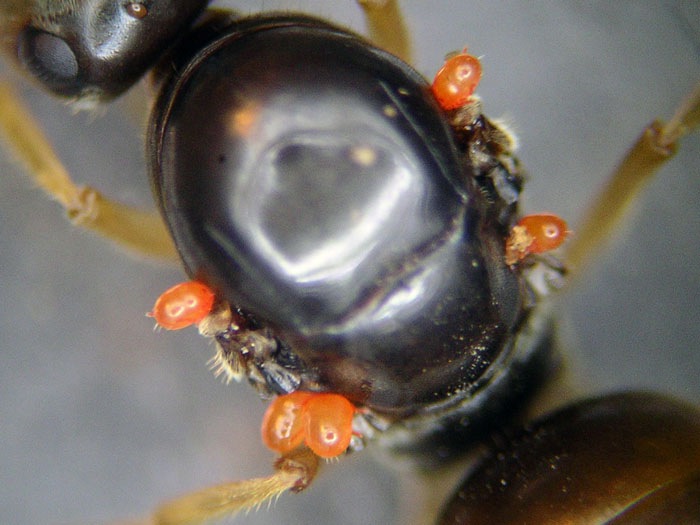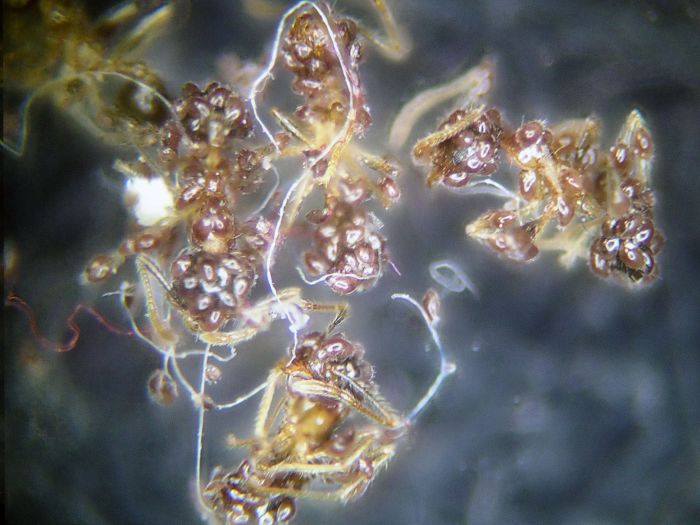click to enlarge


click to enlarge

Current ant colonies -
1) Opisthopsis Rufithorax (strobe ant), Melophorus sp2. black and orange, Pheidole species, Pheidole antipodum
Journal = http://www.formicult...ra-iridomyrmex/
Heterotermes cf brevicatena termite pet/feeder journal = http://www.formicult...feeder-journal/
soaked that queen under water for 15 mins, she went dormant after 6 mins.
That should drown the mite, if it is one, but after taking her out, it looks like it's still there, but maybe dead.
She stirred after a few mins on tissue
these jewellers loupe 30x magnifying glass from Ebay are pretty good for looking at things like this ![]()
she kept floating, so had to use an upside down vial lid, filled with water, to push her down 1cm under the water
Current ant colonies -
1) Opisthopsis Rufithorax (strobe ant), Melophorus sp2. black and orange, Pheidole species, Pheidole antipodum
Journal = http://www.formicult...ra-iridomyrmex/
Heterotermes cf brevicatena termite pet/feeder journal = http://www.formicult...feeder-journal/
Many species of mites associated with ants are strictly phoeretic as opposed to parasitic. The former are larger and more active (which yours appears to be) as opposed to the much smaller, pale colored, relatively immobile parasitic forms.
This mite doesn't appear to move at all if it is one, even after a 15min water submerge which should drown it.
If it is, and it is still alive, I think the minor workers that tend to climb on these queens ala Carebara ants should remove it
Current ant colonies -
1) Opisthopsis Rufithorax (strobe ant), Melophorus sp2. black and orange, Pheidole species, Pheidole antipodum
Journal = http://www.formicult...ra-iridomyrmex/
Heterotermes cf brevicatena termite pet/feeder journal = http://www.formicult...feeder-journal/
You put this queen under water for 15 minuets?
You put this queen under water for 15 minuets?
Yeah, they go dormant after a few minutes, and sometimes produce an air bubble they can breath from.
Then they will revive after a few minutes on tissue.
Ants can live over 24 hours under water, since they have no lungs ![]()
Edited by CoolColJ, June 6 2018 - 2:22 PM.
Current ant colonies -
1) Opisthopsis Rufithorax (strobe ant), Melophorus sp2. black and orange, Pheidole species, Pheidole antipodum
Journal = http://www.formicult...ra-iridomyrmex/
Heterotermes cf brevicatena termite pet/feeder journal = http://www.formicult...feeder-journal/
All ants? I knew that RIFA could make air bubbles, but didn’t know about the rest.
My queen made some air bubbles, but I got rid of them just incase it would also save the mite
Edited by CoolColJ, June 6 2018 - 5:42 PM.
Current ant colonies -
1) Opisthopsis Rufithorax (strobe ant), Melophorus sp2. black and orange, Pheidole species, Pheidole antipodum
Journal = http://www.formicult...ra-iridomyrmex/
Heterotermes cf brevicatena termite pet/feeder journal = http://www.formicult...feeder-journal/
All ants? I knew that RIFA could make air bubbles, but didn’t know about the rest.
My queen made some air bubbles, but I got rid of them just incase it would also save the mite
Haha you got rid of her air, but it was a valiant sacrifice. Hope the mite is actually dead and doesn't spread elsewhere.
![]()
![]()
![]()
![]()
Ex igne et in infernum.
While the queen was reviving on the tissue I even brushed the mite with a small paint brush and tried my featherweight forceps on it, and it didn't budge, so not sure what to make of it
Current ant colonies -
1) Opisthopsis Rufithorax (strobe ant), Melophorus sp2. black and orange, Pheidole species, Pheidole antipodum
Journal = http://www.formicult...ra-iridomyrmex/
Heterotermes cf brevicatena termite pet/feeder journal = http://www.formicult...feeder-journal/
Many species of mites associated with ants are strictly phoeretic as opposed to parasitic. The former are larger and more active (which yours appears to be) as opposed to the much smaller, pale colored, relatively immobile parasitic forms.
Not all parasitic mites are like you described. I have had some that were plump and red as you can see here:

And some that look a lot like his.

You put this queen under water for 15 minuets?
Yeah, they go dormant after a few minutes, and sometimes produce an air bubble they can breath from.
Then they will revive after a few minutes on tissue.
Ants can live over 24 hours under water, since they have no lungs
Curse you Transitive Property! You have cursed me again!
Spiders are bugs. ***THEY ARE NOT INSECTS BUT ARACHNIDS**** Settle down spazzy, I used the incredible generic term "bug," to sidestep that.
Spiders have book lungs.
Ants are also bugs..
Ants therefore have book lungs.
Welllllll..... after a google search, I thought most insects had book lungs... Dun learned something new today!

"I'm the search bar! Type questions into me and I'll search within the forums for an answer!"
I just took a photo of my other queen, the one I did not check nor soak, and she too has a mite on her head!
Time for a 30 min soak....

Current ant colonies -
1) Opisthopsis Rufithorax (strobe ant), Melophorus sp2. black and orange, Pheidole species, Pheidole antipodum
Journal = http://www.formicult...ra-iridomyrmex/
Heterotermes cf brevicatena termite pet/feeder journal = http://www.formicult...feeder-journal/
Current ant colonies -
1) Opisthopsis Rufithorax (strobe ant), Melophorus sp2. black and orange, Pheidole species, Pheidole antipodum
Journal = http://www.formicult...ra-iridomyrmex/
Heterotermes cf brevicatena termite pet/feeder journal = http://www.formicult...feeder-journal/
We should respect all forms of consciousness. The body is just a vessel, a mere hull.
Welcome to Lazy Tube - My Camponotus Journal
Good news, the mite has moved off the queen's head, but is now on her thorax towards the upper rear, looks like 3 of them, two different colours
She also just laid some eggs
Also means drowning them doesn't work...
click to enlarge

Edited by CoolColJ, July 16 2018 - 9:06 PM.
Current ant colonies -
1) Opisthopsis Rufithorax (strobe ant), Melophorus sp2. black and orange, Pheidole species, Pheidole antipodum
Journal = http://www.formicult...ra-iridomyrmex/
Heterotermes cf brevicatena termite pet/feeder journal = http://www.formicult...feeder-journal/
That seems like a lot of stress/torture for the queen just to get rid of a hitchhiking mite...
If it's a phoretic mite, it's probably in a regressed development stage where it doesn't have a mouth/doesn't breathe, so trying to drown it probably won't do anything...
It's probably best to provide this queen with the healthiest possible environment, so the mite will drop off naturally.
A small droplet of lemon juice may irritate the mite enough for it to let go. If it does, simply wipe away with a paintbrush and then rinse the spot with water. Be sure not to get the juice in the queen's eyes or ocelli.
Edited by Miles, July 17 2018 - 10:04 AM.
Well this queen passed away just then ![]()
And the mite was still on her back, just one.
I sprayed isopropanol alcohol on her body, and now the mite is gone
so at least that works....
Current ant colonies -
1) Opisthopsis Rufithorax (strobe ant), Melophorus sp2. black and orange, Pheidole species, Pheidole antipodum
Journal = http://www.formicult...ra-iridomyrmex/
Heterotermes cf brevicatena termite pet/feeder journal = http://www.formicult...feeder-journal/
Couldn't you have just taken a cotton swab soaked in ethanol and gently wiped the mite off? In a confined space, the ethanol fumes would temporarily depress the nervous system of aerobic organisms, rendering both the mite and queen immobile.
0 members, 1 guests, 0 anonymous users